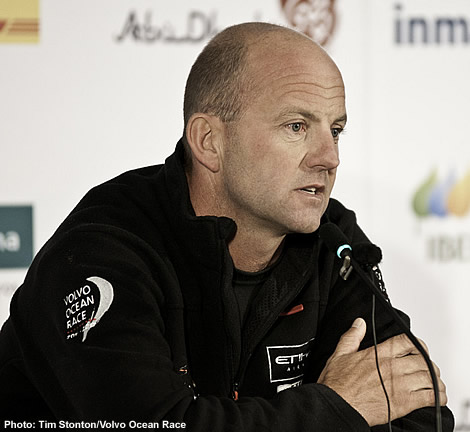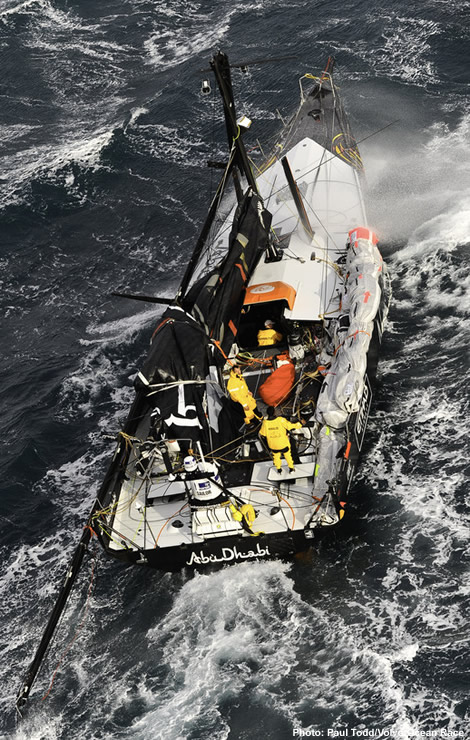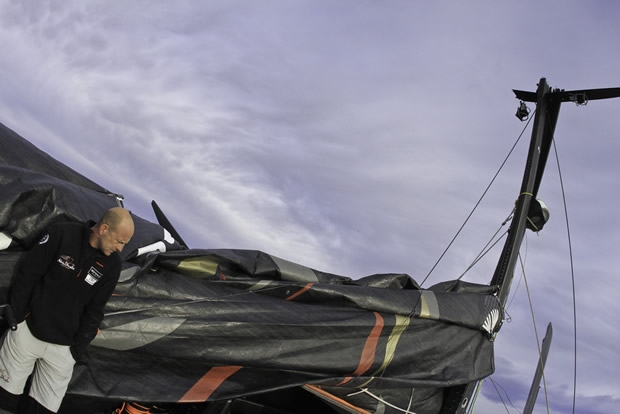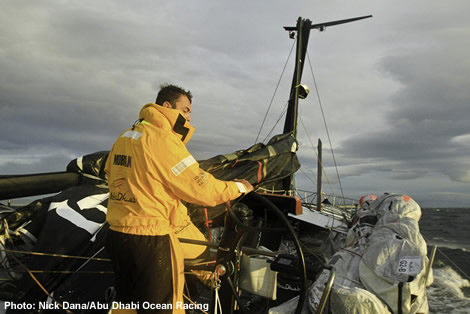Ian Walker on the dismasting
With Abu Dhabi Ocean Racing moored off team base in Alicante this morning, so skipper Ian Walker spoke about what happened when their mast came tumbling down at 19:15 on the first night of the race.
It was dark at the time and according to Walker conditions were windy but not extreme. In fact the wind had been averaging about 30 knots with gusts of 35, but had dropped to 26. This had caused them to change up from their J2 to their J4. That all had gone perfectly: they had squared away the J2 and cracked off to 55deg TWA, the boat speed back up to 13 knots (Walker says upwind they typically go 12-12.5 knot) and they were bashing directly into a seaway.
“The conditions weren’t too extreme, there was perhaps a 1-2m chop,” explained Walker. “These boats are always worse close to land - when you are in the ocean the waves are longer. What these boats don’t like doing is jumping off waves in short chop. It was a pretty dark night so it was hard to see what was coming your way. There were five other boats that sailed through there at exactly the same speed. We expected to back off after the Cape. We were expecting bigger conditions. I suspect the guys that are out there are facing bigger conditions [now] and are backing off. We had fully discussed that, that was always our plan – ‘let’s just get through this and get out’ - we felt we were still in perfectly suitable conditions for racing.”
But then all of a sudden Abu Dhabi Ocean Race fell off a particularly large wave.

Walker was on the helm when the mast came down. “I know it is a big wave when my feet leave the ground. We were falling off the back of a wave and you always have your heart in your mouth a little bit. When we landed the mast just kept going.”
The mast fell to leeward. They immediately carried out a role call to make sure that in the dark no one had fallen overboard in the incident. Everyone was present and correct and no one was injured in the incident.
They then set about recovering all they could of the rig. This is a downside of the new sail limitations in the race. As Walker explained: “One of the problems we had with the rig and sails in the water was that ordinarily you might chop the rig away because the rig can damage the boat. We couldn’t do that. We only have one mainsail and you are only allowed 17 sails for the race and you can’t go throwing two sails over the side.”
The problem was compounded because all the sails are on halyard locks and of course all the locks were underwater at this point making retrieval of the sails particularly hard. They managed to winch the mast alongside but in the process spreader four was starting to punch a hole in the topsides. “The closer we got the mast to us the more damage we were doing to the boat. So we were in a little bit of a fix as to what to do,” said Walker.
In the end Australian Wade Morgan came to the rescue, donned his survival suit, lifejacket and, attached to the boat with a retrieval line, jumped overboard to cut off the heads of the mainsail and J4 (as the video below shows). “He did a good job,” said Walker.
Getting the broken sections of mast and sails back on board took around an hour and a half before they were able to start motoring back to Alicante.
Walker was unwilling to jump to conclusions as to why the mast had come down. While Future Fibres, the manufacturers of the carbon spar and its solid carbon rigging were one hour up the road in Valencia, other experts were also flying into Alicante today. “We are going to spend most of today trying to ascertain what failed first. Obviously you can have failures which are the result of an initial failure, so it is easy to jump to the wrong conclusions.”
They have been testing their solid carbon rigging for a year now (including on their training boat) and the rods fitted to their new VO70 are now third generation. “We have done 8,000 miles in this boat and we have sailed in worse conditions than we faced last night. Maybe it is just when you are racing you are fully loaded, you are pressing that much harder, you are desperate not to back off. We wouldn’t have started the race if we didn’t have confidence in all our equipment.”
Masts typically come down for one of three reasons – a fitting breaking, rigging failure or mast compression. However, despite their carbon spar being one of the first Future Fibres/Persico has built, Walker said it was unlikely to have been a compression failure simply due to the conservative minimum spec for the mast laid down in the Volvo Open 70 rule. “In the last race we had no failures. Mast failures in VO70s are actually quite rare considering what we put them through. I don’t want to second guess what’s happened but generally you would look more towards rigging and fittings and many of the boats in the fleet share the same manufacturers of those.” In particular Team Sanya will be concerned since they too have a Future Fibres mast and rigging.
It is imperative that they do find out what broke. The Abu Dhabi Ocean Racing team has a spare mast and rigging, but it is identical to the kit that broke. “Clearly if we felt there was something wrong with the mast - ie it could happen again - that would alter our plans moving forward. Right now we are working on that. We will spend the rest of today and tomorrow working on that. In the meantime we will work towards getting the new mast ready to go, turning the crew around and getting to Cape Town as soon as we can.”
The spare mast was on a trailer with Telefonica’s spare, en route to Holland where it was going to stored with DHL. However they managed to get the lorry halted outside of Madrid and their mast offloaded. The spare mast is due into Alicante this evening.
As to how long it will take Abu Dhabi Ocean Racing to get back on to the race course, Walker guessed it could be three days, two if they were lucky or four at most. The broken mast has been stripped of all its fittings but the new mast has to be fully dressed all the lashings made up, etc. As Walker says the sails are valuable (they only have one mainsail) and so have to be repaired. There are some holes in the main and the J4 spent an hour and a half acting as a sea anchor, but should be fine. His concerns aren’t really there. In addition to the mast and sails, there are further jobs such as replacing all the stanchions on the port side which were wiped out when the mast came down, plus there is the damage to the hull from the stanchion, which Walker says damaged the outside laminate but didn’t compromise the hull's internal skin. The boat was coming out of the water and they would carry out a full check of the hull for any further areas of delamination.

Offers of support have come in from the other teams and Walker said that was one of the stand-out features of the Volvo Ocean Race: how competitors rally to help each other whether it is on sea or on land in times of need. “It is amazing what you can do if you have a strong will. We have had a lot of offers of help. We’ll get people on it 24 hours a day and sometimes you’d be amazed what people can achieve in a very short time,” said Walker. “We are very grateful for the offers of support and we will certainly them up on that if it can get us back on the water sooner.
“Everybody put so much work into this project, you just don’t want to let anyone down. When you have worked so hard every day for 18 months, you are desperate to do well and we still are. The race isn’t lost. Sometimes these things can galvanise a team. We saw that last time with the Green Dragon when we broke the ring frame in the bow. If I had to point to one thing in the whole of that race that galvanised the team and got us through what was a difficult race, it was rebuilding our boat in the Philippines and enduring the conditions and getting to China. You have to look at it objectively. We are very fortunate no one was hurt. We are all still here to tell the tale. We have a spare mast. Our sponsors are hugely supportive. They phoned me up straight away offering me all the support. This race is not over for us.
“On a personal level and for everyone else in the team – very very disappointed, not least because this is the best leg of the race and I couldn’t wait to do the downwind sailing which I think our boat is more optimised towards and some of our sails. So I was desperate to get into the Trade Winds because I really felt that was where we were going to excel. But that is going to have to wait for another three or four days maybe.”












Latest Comments
Add a comment - Members log in